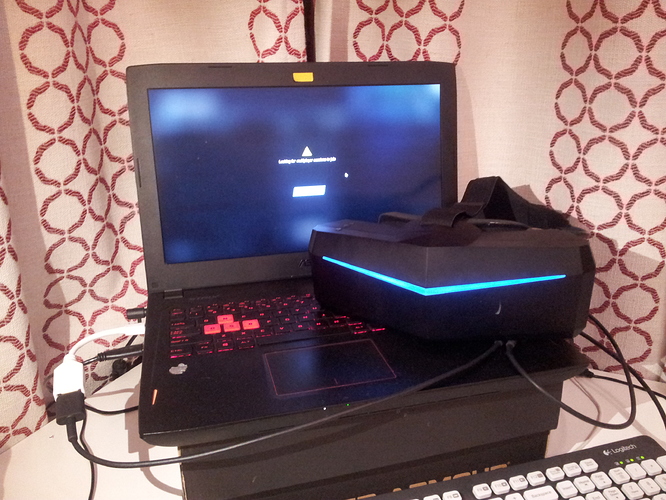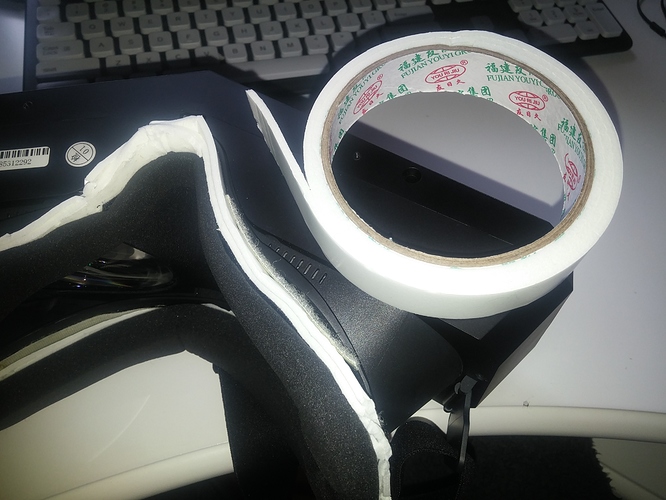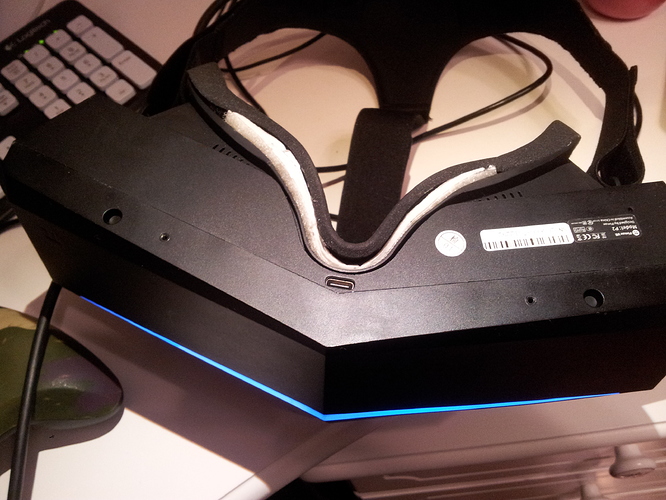Here’s a few tips and a short review of my experience with the Pimax 5K+ working with a GTX1070 laptop. I am pleasantly surprised that even with a puny laptop like mine, you can get good framerates in a lot of games, if you can accept medium to low graphics settings. I have included a review of some individual games that I have tried at the end of this post.
But let’s first look at a few tips to get the best performance.
A few tips for smoother performance
For some games setting the game process priority to high using Bill2’s Process Manager (Accueil - Bill2's Process Manager - Gestionnaire de processus automatique pour Windows 2000/XP et Vista ) will reduce microstutters.
Also disabling all network traffic seems to help (activate Airplane mode).
I guess this is because it prevents the CPU from wasting cycles on other tasks while you are playing the game. It does seem that these tricks mostly work for older games, though.
Tricks to get higher rendering resolution in certain apps/games
Ethan Carter VR (and possibly a few other games like EVE Valkyrie):
This game was originally reported as ‘not working with Pimax 8K/5K’, because of a horribly low display resolution it looked very pixelated.
It seems the problem is due to a bug in Unreal Engine 4.15 that causes the HMD render to be limited to the desktop preview resolution (see https://www.reddit.com/r/Pimax/comments/axl2l9/apparently_the_vanishing_of_ethan_carter_vr_found/ )
So if your Windows desktop is running in 1920x1080, then that is the maximum resolution that the game will render, no matter what settings you apply in PiTool and SteamVR. If you have a 4K or 8K monitor connected to you computer, then the game will render fine, but most of us don’t have that sort monitors.
The workaround for that is to use a Headless Ghost (yes, that is the name of the device, see http://headlessghost.com/). When you plug it into the HDMI port, the computer registers it as a 4K monitor, which allows you to render the Windows desktop in 4K (4096x2160). The only downside is that this makes the screen on my laptop go blank, because it cannot handle 4K. So the way I start the game is to first open a Desktop view in the headset via SteamVR, and then plug the Headless Ghost in the HDMI port. After that the Windows desktop shown in the headset can be set to a resolution of 4096x2160, and when you start up the game, it will be rendered in that resolution.
4K Headless Ghost inserted in HDMI port, zoomed in through-the-lens photo:
4K Headless Ghost removed from HDMI port, zoomed in through-the-lens photo:
A few more tips from Heliosurge on running Ethan Carter:
“You need small fov & pitool setting if mem serves of 0.5 or 0.75. Normal & Large fov make textures look very low res & text shimmery to unreadable. “
I assume the reason why a larger fov looks worse is that the fixed rendering resolution of the game gets stretched over a larger area, which means that each rendered pixel looks bigger. So the game still has some bugs, but the good news is that its not very demanding on the hardware, and runs perfectly smooth even on a GTX1070.
Virtual Desktop:
This app has the same problem, it will only render the desktop in the maximum resolution of the monitor. Unless you have a 4K monitor attached to your computer, the text and icons on the virtual desktop in your headset will look pixelated. You will get a much better image quality if you use a Headless Ghost to allow Virtual Desktop to render in a higher resolution. This is actually also what a dev suggests in this thread:
https://steamcommunity.com/app/382110/discussions/0/385429091862933902/
With this higher resolution text becomes much more easy to read in Virtual Desktop, especially if you also set supersampling to a higher value.
Other games that work with a GTX1070
I have tried the following games and found that they work OK with my setup:
Subnautica: Works fine with low settings, apart from the common display problems that this game has in every VR headset.
World of diving: Works fine with the Pimax 5K+, its just not a very good game compared to Subnautica.
Assetto Corsa: Works fine after a lot of adjustmens, there are some good guides on the Pimax forum on how to get the most out of this game in VR. Most notably, you have to turn off the postprocessing filter and install a custom launcher to get the best results. But after that it runs really great, and almost without any aliasing even on a GTX1070.
Live for Speed: After installing a custom patch it runs fine with the Pimax, but aliasing seems to be worse that in Assetto Corsa. Maybe fiddling with some of the settings will solve it, I haven’t spent much time on it yet.
Project Cars 2: At first this game was unplayable, but following the instructions here: https://community.openmr.ai/t/how-to-play-project-cars2-on-pimax-8k-5k-without-parallel-projections-and-steamvr/18644 it is now possible to run it even on my GTX 1070. I set small FOV i Pitool, all graphics settings in PCars2 to low/off except for MSAA and texture filtering, and set the following values in
…\Documents\Project CARS 2\graphicsconfigoculusdx11.xml
<prop name="AntiAlias" antialias="1" />
<prop name="SMAAFXAA" smaafxaa="0" />
<prop name="Windowed" windowed="0" />
<prop name="TextureFilter" texturefilter="4" />
<prop name="TextureResolution" textureresolution="0" />
<prop name="Brightness" brightness="10" />
<prop name="CarDetailLevel" cardetaillevel="0" />
<prop name="TrackDetailLevel" trackdetaillevel="0" />
<prop name="ShadowDetailLevel" shadowdetaillevel="0" />
<prop name="MotionblurLevel" motionblurLevel="0" />
<prop name="EffectsDetailLevel" effectsdetaillevel="0" />
<prop name="EnvmapDetailLevel" envmapdetaillevel="0" />
<prop name="MirrorEnabled" mirrorenabled="0" />
<prop name="MirrorEnhanced" mirrorenhanced="0" />
<prop name="EnvmapReflectionDetailLevel" envmapreflectiondetaillevel="0" />
<prop name="GraphicsLevel" graphicslevel="0" />
<prop name="SuperSampling" supersampling="0" />
<prop name="LowSuperSampling" lowsupersampling="0" />
<prop name="VRSuperSampling" vrsupersampling="0" />
and the following in …\Documents\Project CARS 2\oculussettings.xml
<prop name="HideCrowds" data="true" />
<prop name="Limit Movement" data="false" />
<prop name="VSync" data="false" />
<prop name="OnlyPlayer" data="true" />
This gives acceptable framerates, aliasing and clarity.
Aerofly: Works great, in my opinion one of the best experiences on the Pimax. Even on fairly high graphics settings it delivers smooth and high framerates. Being able to look around in the cockpit with a natural field of view is a totally different experience from just viewing it on a screen.
DCS: This game was also labeled as unplayable, so I was surprised that it actually works OK with all settings except general/cockpit textures set to low. Perhaps it’s because of some recent optimization or maybe Smart Smoothing works particularly well with this game. I noticed that the ingame FPS indicator shows 32 FPS, but still everythings seems very smooth.
VTOL VR: This game only works with VR controllers, so I havent been able to play it properly. I was able to start up the game and pull the ejection handle, though, and the graphics and framerate looked like they were OK on that brief flight.
Eagle flight: Works fine except for a strange vignetting effect, when you fly close to objects the area near the borders of your field of view become dark. This doesn’t affect the gameplay much, though.
Ultrawings: Fairly simple graphics gives this game high framerates, even on my GTX1070. But you need VR controllers to really enjoy this game.
WarThunder: Runs reasonably well for me, it would be nice with a bit more sharpness in the distance, but the wide field of view and head tracking makes it much easier to maintain situational awareness and spot your enemies before they shoot you down.
EVERSPACE: Works just fine, but does need fairly low graphichs settings to run smoothly on my system.
Endspace: Runs a bit better, with higher frame rates.
Elite Dangerous: Runs well with medium graphics settings and small FOV setting in Pitool
Race the sun: Simple graphics, runs with no problems at all
Vector 36: Runs fine without any changes to the settings.
VR Regattta: A nice little sailing game, runs without problems, and its nice to enjoy the colourful graphics with a natural field of view.
Skyrim VR: Works perfectly without any tweaking needed, haven’t had time to really get into the game yet, but I look forward to enjoying the scenery in VR.
Richard Burns Rally: This game was originally not made for VR, but some clever modders figured out how to patch it, so that it now runs perfectly in VR. The graphics in the game are not very high quality, as you might expect with a game originally released in 2004, but this also means that system requirements are very low, so it runs smoothly even with a Pimax 5K+ and a GTX1070 GPU. At the moment this is my favourite game, rallying in VR with a wide field of view is pretty amazing.
Here are the instructions for making it work in VR: FREE VR RALLY SIMULATOR | Richard Burns Rally HTC Vive VR Gameplay - Dirt Rally VR competitor! - YouTube
RUSH: Runs fine with medium graphics settings. I did run into one problem: For some reason the image in the game suddenly became dark an a bit blurry. Perhaps I just had pushed some wrong button, but this was solved by deselecting the option ‘Enable the Steam Overlay while in-game’.
Dirt Rally: It was a bit of a hassle to set it up, and it quickly stopped working again. As far as I can gather from different information in various forums, it seems that this game only works with certain versions of SteamVR and Revive. But the one time it did work, it seemed to run pretty OK on my laptop.
Euro Truck Simulator 2: This game is both good and bad in VR. It’s great to be able to look around, and driving in traffic feels much more natural with a wide field of view. And if you want to enjoy the scenery, you just turn your head and look out the window. But the games graphics engine was never very good, it always suffered from aliasing, and in VR its much worse. So far I haven’t been able to get it to run with a satisfying frame rate and image quality. Perhaps there is some tweaking that can be done to get it to look perfect, but I haven’t figured it out yet.
A couple of games that didn’t work so well
Redout: Seems it would be OK without Parallel Projection, but that doesn’t work, so the framerate is too low on my computer
Falcon BMS: Tried running this via Virtual Desktop using the tutorial found here.
https://wiki.hoggitworld.com/view/BMS_VR_Setup
But if I turn up the resolution high enough to be able to see the instruments, the framerate gets too low. And the cockpit textures are too dark. Perhaps if the cockpit textures were modded to be a bit brighter and instrument text clearer, it might work.
A bit more about my setup
My computer is an Asus ROG Strix GL502VS with a GTX1070 GPU, almost identical to the one used in Swevivers review. ( Gaming on Pimax 8K & 5K+ with GTX 1070 Laptop? 19 VR Games Tested with Benchmarks! - YouTube ) I haven’t overclocked the GPU or CPU yet, but that might give a bit better performance once I get it done.
I personally dont care much about the quality of shadows, reflections and other lighting effects, but I hate aliasing and flickering pixels. So my base settings are usually a quality setting of 1.0 in PiTool and resolution setting of 100% in SteamVR, and all graphics setting set to minimum in the game menus. Refresh rate is set to 64 Hz in PiTool and field of view is Normal. With those settings most games run smoothly, and in a lot of games I can increase the settings to get better visual quality without the framerate dropping below 64 fps. Smart Smoothing (BrainWarp) kicks in and helps if the framerate drops below 64 fps, but it makes fast moving object flicker, so I prefer to find settings where Smart Smoothing is not active all the time.
Wearing the thing
I was initially a bit disappointed with the image quality, but afterwards I found out that I simply had to be more careful how I position the headset. If its too close the the eyes, the rings in the fresnel lens become visible, and if its too far away, it starts to show weird distortions around the edges of the image. And of course you have to place it correct vertically and horizontally and with the right IPD to find the sweetspot and get a clear image.
My eyes are mildly myopic, but I can usually read books without wearing glasses, so I thought that I wouldn’t need to wear glasses in the Pimax, but that is not the case, I cannot focus on the image without glasses.
After dealing with the above issues, I found the image in the Pimax 5K+ to be sharp, without any noticable distortions.
Avoiding condensation/fogging
Where I live we dont have heating in the house, so the Pimax and my eyeglasses are usually pretty cold before I put them on. So when I put them on and the warm, moist air from my skin hits the lenses, they immediately get misty with condensed water. I solve this by preheating the headset and my eyeglasses with an electric blanket for a few minutes before putting them on, after that there are usually no problems with water condensing on the lenses.
Wearing glasses
Initially I had some problems wearing eyeglasses inside the HMD without them touching the Pimax lenses. If the eyeglass lenses are constantly rubbing against the Pimax lenses, both will eventually get a lot of scratches, so it has to be avoided.
My first solution was to add two layers of thick doublesided tape covered in velcro between the face cushion and the HMD. That way there was a little bit more room for mye eyeglasses.
But I found that placing the headset just a few millimeters too far from my eyes caused strange distortions around the left and right edges, so now I just adjust my eyeglasses to be closer to my face instead. I have removed the double sided tape and just left a little around the nose, to avoid light coming in from that area.
Using sunglasses
A user on the Pimax forum suggested using sunglasses inside the headset to improve black levels. At first it seemed a bit silly to me, of course you get better black levels if you use sunglasses to block half of the light coming from the LCD’s. But perhaps there is more to it than that. I tried it out, and it looks to me as if contrast and vibrance is genuinely improved when you wear sunglasses. My theory is that black levels and contrast is reduced by light bouncing around in the headset because it gets reflected from the surface of lenses and the users face. A good pair of polarizing sunglasses don’t just filter out a certain amount of the light that passes through them, they mainly filter out reflected light (see Polarizing filter (photography) - Wikipedia). So when you put on polarizing sunglasses in the Pimax, you see more of the light coming directly from the LCD’s and less of the light that is reflected from the surfaces of the lenses. Anyway, if you have a pair of sunglasses it might be worth a try, I find that it helps when reading white text on black backgrounds and playing space shooters.
Avoiding white flashing pixels
I found that the DisplayPort cable is very sensitive to poor connections.
Especially when using a MiniDP adapter, you have to be careful that the connector is not pulled in any direction. Even the wight of the cable itself can be enough to cause a bad connection and poor image quality:
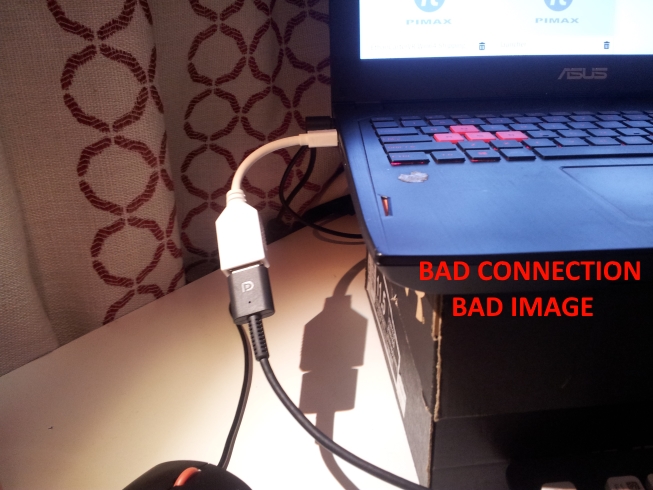
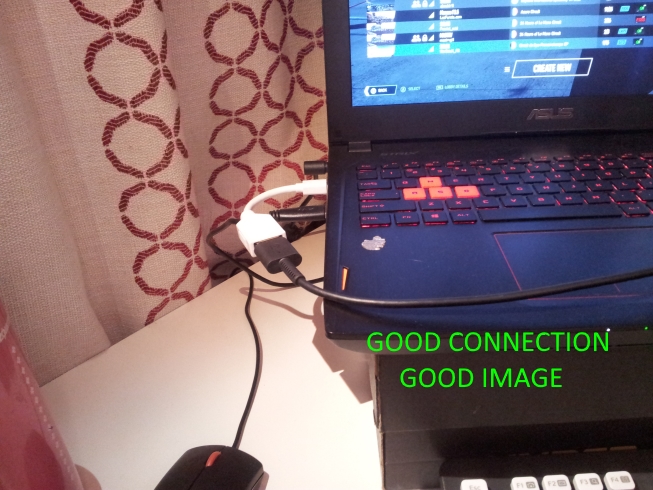
The controllers
Well, I havent received them yet, but they sure look nice on the pictures ![]()
Since a lot of games and apps are not playable without controllers, I use the emulation shown in this video: Google Earth VR without Touch (tracked motion controllers) using X-Input/XBOX360 controller on Steam - YouTube
It makes it possible to use an Xbox controller as if it’s a pair of Vive controllers. You can’t really use it to play games, but at least you can try out different VR apps and games using this method.
Tracking
I have no lighthouses, but the integrated head tracking in the Pimax works well for me. Some users have reported drifting issues, but I haven’t experienced any yet. The only time I had to recenter was after crashing a plane in Aerofly, I guess in that case the movement was too violent for the tracking to keep up.
Motion sickness
I have felt motion sick in other headsets, but not in the Pimax. Whether it’s the higher field of view or just me getting used to VR, I don’t know.
Problems with the hardware
None so far. I was a bit worried when I saw how many problems many of the early backers had, but my unit has worked flawlessly for a couple of months now. Maybe it’s because my backer number is pretty high, so by the time they came around to assembling my unit, most of the quality issues had been sorted out.
UPDATE: Today I noticed small cracks in the housing, at the upper corners where other users have also reported the same problem. Not sure if it’s worth asking for a replacement, the problem is purely cosmetic, and I am not planning on selling the unit anytime soon. But it will be a bit of a headache for Pimax if most or all of the headsets develop cracks like this, and people start asking for replacements.
Conclusion
I had lots of worries about this project: Would my computer be able to drive the Pimax 5K+, would it make me sick like other headsets did in the past, would it break down after a few weeks or even work when I got it, and so on.
But so far my experience with Pimax has been positive, so it gets a big thumbs up from me.
